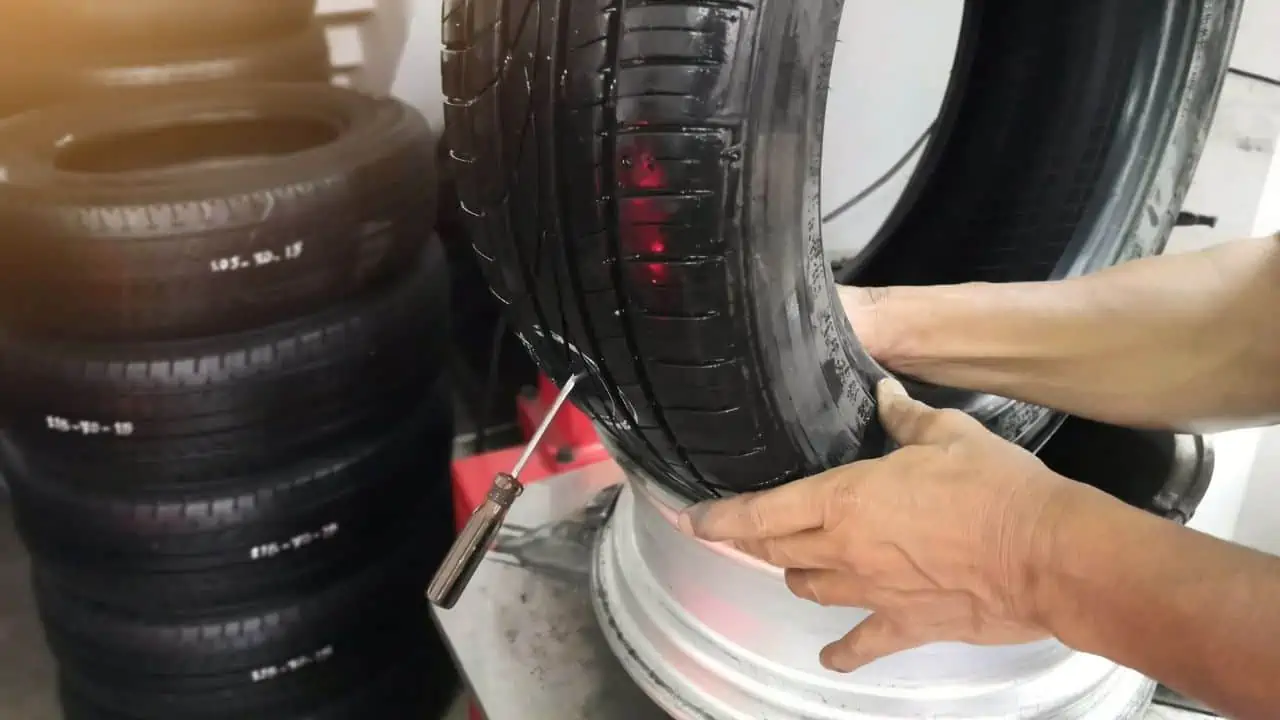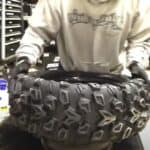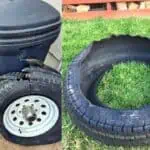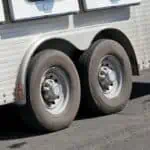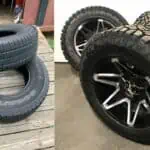If your tire goes flat and you’re in a pinch, you may be wondering if it’s possible to patch a tire with just two nails. The answer is yes, but it’s not going to be a permanent fix. Two nails will only get you so far before they start to come out and the hole in your tire gets bigger.
You’ll also need to be careful when driving on nails, as they can puncture other parts of your tires or even cause a blowout. So while it’s technically possible to patch a tire with two nails, it’s not advisable and you’ll need to replace your tire as soon as possible.
- Find the nails
- They are usually in the tread of the tire
- Use a tire iron to pry out the nails
- Use a patch kit to patch the holes left by the nails
You May Like
- Treadlife: N/A
- Tires Only
- Season: All Season, Performance: Performance
- Car Type: Passenger
- Biting edges for superior traction in dry, wet, and snowy surfaces
- Durable tread compound with high grip
- Multiple sipes prevent uneven tread wear
- Treadlife: N/A
- Tires Only
- Season: All Season, Performance: Performance
- Car Type: Passenger
- Treadlife: N/A
- Tire Only
- Season: All Season, Performance: Performance
- Car Type: Passenger
- Enhanced tread compound and profile provide all-season traction
- Offers drivers a smooth ride with controlled handling
- Deep, lateral shoulder grooves allow for excellent traction throughout the life of the tire
- Smooth ride with controlled handling
Can You Patch a Tire With 2 Nails in It?
When Can a Tire Not Be Patched?
There are a few instances when a tire cannot be patched. If the sidewall of the tire is punctured, if the tread is worn down to the bare minimum, or if there is already a patch on the tire, then it cannot be patched. In addition, if the puncture is too close to the edge of the tire, it may not be safe to patch it.
Can You Patch a Tire With Multiple Holes?
If you have multiple holes in your tire, patching it is not going to be a viable option. You might be able to get away with it if you have one small hole, but anything more than that and you’re going to need to replace the tire. The reason for this is that when air escapes from a tire, it does so through the path of least resistance.
That means that if there are multiple holes, the air is going to escape from all of them, not just one. This will result in a flat tire very quickly. So if you have more than one hole in your tire, the best thing to do is replace it.
Can You Put Two Plugs in a Tire?
Most people believe that it is not possible to put two plugs in a tire, but this is a myth. While it is true that most tire manufacturers do not recommend doing this, it is perfectly safe to do so if done correctly. If you have a puncture in your tire and need to plug it, simply insert the first plug into the hole following the manufacturer’s instructions.
Once the first plug is in place, take the second plug and insert it next to the first one. Make sure both plugs are snug and secure before inflating the tire. While having two plugs in a tire may not be ideal, it is perfectly safe and will get you back on the road until you can get your tire replaced or repaired.
Is It Better to Plug Or Patch a Nail in Tire?
If you have a nail in your tire, it’s important to act quickly and repair the puncture. But what’s the best way to do it? Should you plug or patch the tire?
There are pros and cons to both methods. Plugging is generally quicker and easier, while patching is more permanent. Keep reading to learn more about each option so you can make the best decision for your situation.
Plugging a Tire To plug a tire, you’ll need to remove the nail and insert a special plug into the hole. These plugs expand as they’re inserted, so they create a tight seal.
You can then inflate the tire and be on your way. One advantage of this method is that it’s relatively quick and easy to do yourself. You don’t need any special equipment beyond a plug kit, which you can find at most auto parts stores.
And if done properly, a plugged tire can last for years without any issues. However, there are also some disadvantages to consider. First, not all tires can be safely plugged – especially if the puncture is close to the sidewall of the tire.
Second, even if your tire can be plugged in, it’s not always considered safe by insurance companies or state inspection programs (such as emissions testing). Finally, although rare, a plugged tire can fail suddenly – resulting in an accident or blowout. Patching a Tire
Patching a tire is similar to plugging in that you’ll need to remove the nail and then insert something into the hole – but in this case, it will be a patch (usually made from rubber or metal). The patch is then glued or vulcanized onto the inside of the tire so it bonds with the rubber permanently.
Once dry/cured, you can inflate the tire and be on your way. patching offers several advantages over plugging. For starters, it’s considered much safer since patches bonded onto the inner linings of tires cannot come loose like plugs might.
This means there’s no risk of sudden failure or blowouts. Additionally, patched tires are often accepted by insurance companies and state inspection programs.
Finally, patches usually last longer than plugs – meaning you won’t have to worry about fixing them again anytime soon.
Of course, there are also some downsides. First, patching takes more time than simply plugging – so if you’re stranded on the side of the road, it may take a while before help arrives.
Second, patches typically require professional installation – meaning you’ll have to pay someone to do it for you unless you have experience with this type of repair yourself.
Third, depending on where the puncture is located, patches may not be an option at all – since they require access to the side wall of the tire which isn’t always possible.
Can You Patch a Run Flat Tire With a Nail in It
If you have a nail in your tire, you may be able to patch it if the puncture is in the tread and not too close to the sidewall. If the puncture is in the sidewall, it’s not safe to patch and you’ll need to replace the tire. To patch a run-flat tire with a nail in it:
1. Remove the nail and any debris from the puncture site with pliers.
2. Clean the area around the hole with rubbing alcohol.
3. Apply a generous amount of tire sealant to the hole.
4. Insert a plug into the hole and inflation valve stem. Inflate the tire according to the manufacturer’s instructions.
Do You Have to Replace a Tire With a Nail in It
If you have a nail in your tire, you may be wondering if you need to replace it. The answer is it depends. If the nail is in the tread of the tire, then it can probably be repaired.
However, if the nail is in the sidewall of the tire, then it will likely need to be replaced.
How Close to Sidewall Can a Tire Be Patched
If you’ve ever had a flat tire, you know that it’s not a fun experience. Not only do you have to deal with the inconvenience of having a flat, but you also have to worry about getting it patched up. But how close to the sidewall can a tire be patched?
It turns out that there is no definitive answer to this question. It depends on the type of patch that is being used and the condition of the tire. If the patch is simply covering a hole, then it can be placed quite close to the sidewall.
However, if the patch is being used to reinforce a weak spot in the tire, then it needs to be placed further away from the sidewall to be effective. Ultimately, it’s best to consult with a professional when deciding where to place a patch on your tire. They will be able to assess the condition of your tire and determine the best location for the patch.
So if you’re ever in need of a tire patch, don’t hesitate to ask for help!
How Big of a Hole Can You Patch in a Tire
You can patch a pretty big hole in a tire with some quick-fix methods, but it’s not always the best idea. If the hole is bigger than a quarter, you’re likely better off replacing the tire.
If you absolutely must patch a larger hole, start by cleaning the area around the hole with alcohol to remove any grease or dirt.
Then use a utility knife to cut away any jagged edges of rubber.
Next, apply vulcanizing cement to both the inside and outside of the tire around the hole. Be sure to press it into place well so that it will adhere properly.
Finally, place your patch over the hole and press it down firmly. Allow everything to dry for at least 24 hours before driving on the patched tire.
Nail in My Tire But Not Flat
If you’ve ever had a nail in your tire, you know it’s not a fun experience. You may be wondering why your tire is still inflated if there’s a nail in it. The answer is that the air inside your tire is under pressure, so the hole from the nail isn’t big enough to let all the air out.
However, if you continue to drive on a tire with a nail in it, eventually the pressure will cause the tire to go flat. It’s best to get the nail removed and patched as soon as possible to avoid further damage to your tire.
How Many Times Can a Tire Be Plugged
Most people believe that a tire can only be plugged in once, but this is not the case. A tire can be plugged in multiple times, as long as the plugs are properly installed and maintained. Tire plugs are typically made of rubber or other materials that can easily be inserted into a punctured tire.
These plugs act as a temporary fix for a puncture, stopping air from escaping through the hole in the tire. While they are not meant to be a permanent solution, they can often last for several months or even years before needing to be replaced. The number of times a tire can be plugged depends on several factors, such as the size of the puncture and the type of plug used.
In most cases, a tire can safely be plugged 2-3 times before it needs to be replaced. However, if the puncture is large or if the plug does not seem to be holding up well, it is best to replace the tire sooner rather than later.
If you do need to plug your tires more than once, make sure to keep an eye on them and check for any signs of leaks regularly.
It’s also important to have your tires inspected by a professional every few years to ensure they are still in good condition and haven’t sustained any additional damage.
How Old Can a Tire Be to Repair
Although it is generally accepted that a tire should be replaced after six years, this may not always be the case. In some instances, a tire can be repaired rather than replaced outright. Of course, there are a few factors that will come into play when making this decision, such as the severity of the damage and the age of the tire.
If a tire is old but has sustained only minor damage, it may be possible to have it repaired rather than replaced. For example, if you have a small puncture in your tire, you may be able to have it plugged in or patched by a professional. However, if the damage is more severe—such as a large gash or hole—then you will likely need to replace the tire completely.
Age is also an important factor to consider when deciding whether to repair or replace your tire. If your tire is older than six years, it might not be worth repairing since its lifespan may be shorter than a newer tire.
Additionally, an older tire may not perform as well as a new one and could potentially put you at risk while driving.
Ultimately, it’s up to you to decide whether repairing or replacing your old tires makes the most sense for your situation.
Can You Repair a Punctured Tire
A punctured tire is a big pain and can ruin your day. But before you write it off as a lost cause, there are a few things you can try to repair it. If the puncture is small (less than 1/4 inch), you may be able to simply plug it in with a tire repair kit.
These kits are available at most auto parts stores and usually, come with everything you need to repair. Just follow the instructions on the package. If the hole is bigger than that, or if the kit doesn’t seem to be working, you’ll need to patch the tire from the inside.
This is a little more complicated, but still doable if you’re comfortable working with tools. You’ll need to remove the tire from the wheel (which will require a jack and some lug nuts) and then use a special adhesive patch to seal up the hole from the inside. Again, there are kits available for this at most auto parts stores.
Of course, sometimes a punctured tire is just too far gone to be worth repairing. If that’s the case, you’ll need to buy a new one. But if you’re lucky enough to catch it early, following these steps should help you get back on the road in no time!
Conclusion
It’s a question we’ve all asked ourselves at one point or another: can you patch a tire with two nails in it? The answer, according to one blog post, is yes!
The author of the blog post experimented with this method and found that it worked well enough to get him home safely.
He does caution that it’s not a perfect solution and that you should only use it as a last resort.
So, if you’re ever in a bind and need to patch your tire with two nails, rest assured knowing that it can be done!
